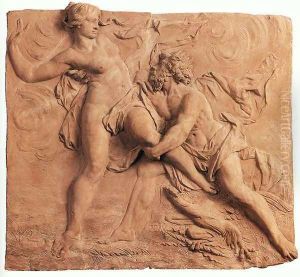Jan Peter van Baurscheit the Elder Paintings
Jan Pieter van Baurscheit the Elder was a Flemish sculptor and architect born in 1669 in Antwerp, Belgium. He was part of a family of artists, which included his father Pieter van Baurscheit, who was also a sculptor. Jan Peter showed an early talent for the arts and followed in his father's footsteps, becoming one of the prominent figures in the Flemish Baroque movement.
Van Baurscheit was not only a sculptor but also took on architectural projects. His work was mostly in the Baroque style, which was characterized by dramatic expressions, grandeur, and movement. He contributed to various religious and secular buildings, providing both sculptural works and architectural designs. Among his architectural contributions, the most notable is the 'Huis Sint-Jacob' on Meir Street in Antwerp, which is still considered an important example of Baroque architecture in Belgium.
His sculptural works often featured mythological or allegorical themes, which were popular during the Baroque period. Van Baurscheit's sculptures can be found in many churches in and around Antwerp. His craftsmanship was characterized by a dynamic use of form and expert handling of marble and wood.
Van Baurscheit also played a significant role in the artistic community of his time. He was a member of the Guild of Saint Luke, an association of artists and craftsmen, which was an essential part of the cultural landscape in Antwerp. His influence extended to his son, Jan Peter van Baurscheit the Younger, who became a notable architect and sculptor in his own right.
Jan Peter van Baurscheit the Elder continued to work and influence the Flemish art scene until his death in 1728. His legacy is preserved in the works that adorn various buildings and in the influence he had on the subsequent generation of artists in the region.
